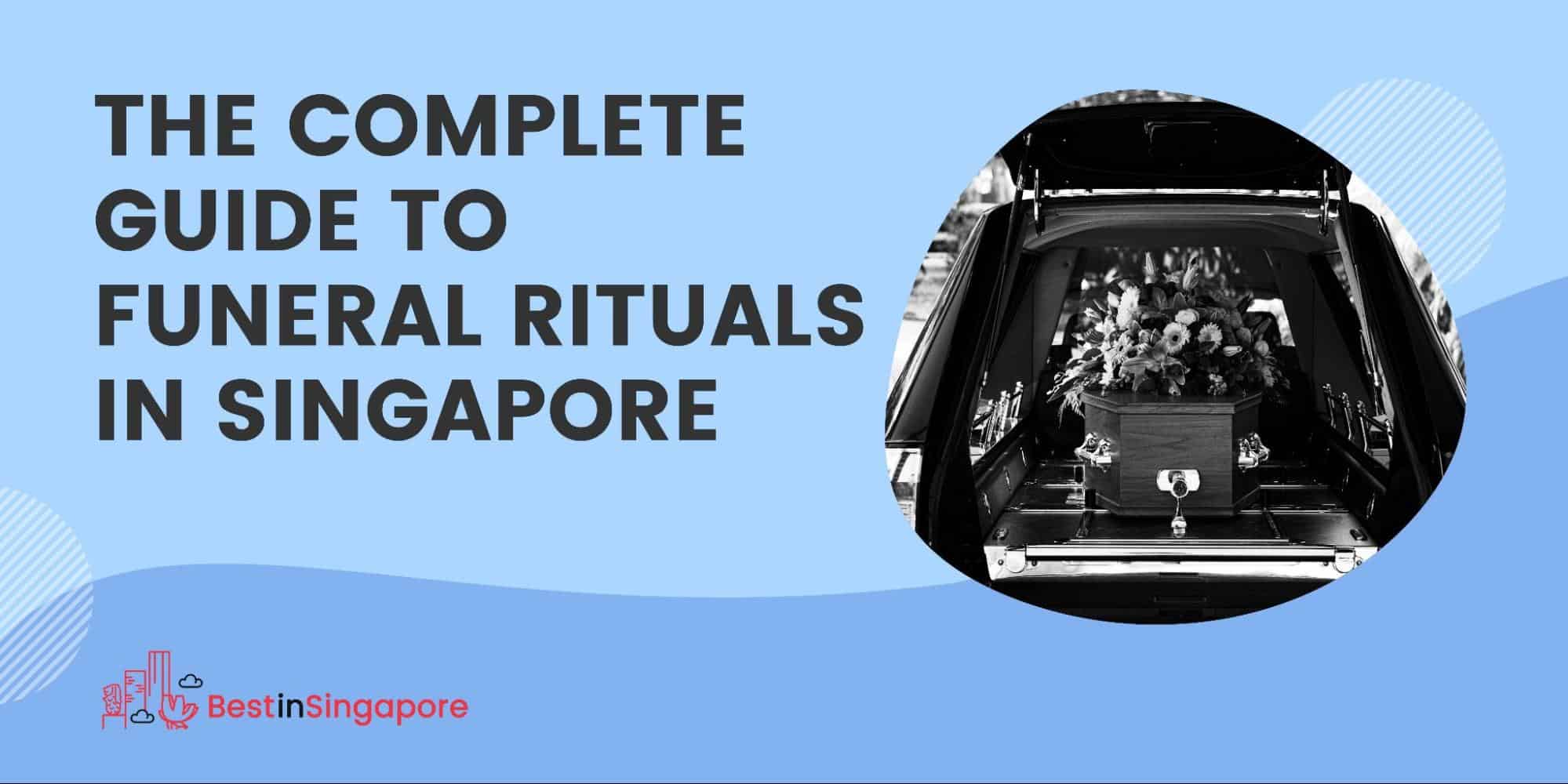The Complete Guide to Funeral Rituals in Singapore
The topic of death can be a touchy subject. But for a cultural melting pot such as Singapore, it can also be a topic of discussion and sometimes confusion, especially if you’re attending a funeral that doesn’t conform to your beliefs.
We curated this complete guide to funeral rituals in Singapore to introduce local funeral rituals based on the most common religious groups. From Buddhist to Christian funerals, we covered the do’s and don’ts, plus all the basics you need to know.
And if you’re arranging a funeral yourself, we also have recommendations on funeral homes you can hire to help you take care of everything while you grieve. If you’re ready, let’s get started.
Buddhist Funeral Rites
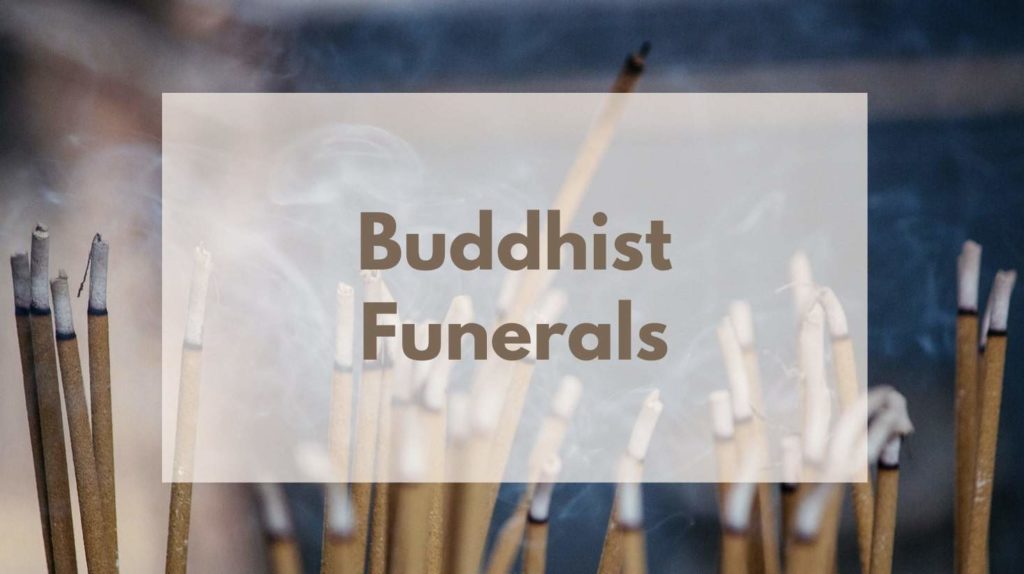
Buddhism is one of the most common religions in Singapore, practised by at least 30% of the population. Hence, it’s also common to find Buddhist funerals in Singapore.
Following the death of a person, some Buddhists specifically request not to touch or move the body of the deceased for at least 4 hours. This is because Buddhists believe that the soul doesn’t immediately leave the body.
From there, the family of the deceased can start making funeral arrangements. Generally, Buddhist funerals should be simple and modest.
For instance, the deceased should be dressed in everyday clothes that they usually wear. Buddhist funerals are usually held from 3 to 5 days in Singapore, usually at the void decks of HDB flats.
Buddhist funerals are also sometimes held in temples or funeral homes. Praying and chanting are common practices during a Buddhist wake. The latter is typically conducted by a monk on the first day, last night of the wake, and on the day of the funeral.
During the wake, the family places an altar near the casket. The altar features an image of the deceased, an image of the Buddha, candles, flowers, fruit, and incense.
Cremation and burials are acceptable in Buddhist traditions. However, plenty of Buddhists tend to go for cremation because Buddha himself was cremated following his death.
In Singapore, cremation is often practised due to the scarcity of land. Besides that, cremation is also more affordable than burials.
Religious Significance
There are two types of Buddhist funeral traditions: Mahayana Buddhist funeral customs and Theravada Buddhist funeral customs.
For the former, the funeral is usually held a few days after death to allow for the initial stage of reincarnation—a central idea in Buddhism that marks the beginning of a new life in a different physical form after death.
Mahayana Buddhists believe that reincarnation can take several weeks, whereas Theravada Buddhists believe that it happens right after death.
Generally, chanting of protective verses plays a key role in Buddhist funerals. It’s believed to help the soul transition out of the body with ease.
Regardless, Buddhists believe that death is a natural and inevitable process that brings the soul closer to nirvana. This is a state of enlightenment that puts an end to suffering.
Do’s and Don’ts
If you’re a guest, it’s important to be respectful to the family of the deceased, even if you don’t share the same beliefs. Be sure to take these do’s and don’ts into account before heading to a Buddhist wake or burial:
Do’s
- Mourners can wear simple black clothing.
- Upon arriving, proceed to the altar and do a slight bow with palms in a praying position.
- Light and offer a joss stick to the altar.
- Although not required, mourners can offer bereavement money called “pek kim” in a small white envelope to help the family cover some funeral costs.
- If chanting or praying is ongoing upon arrival, find an empty seat before approaching the host.
- Likewise, you can simply observe and sit quietly if you’re unfamiliar with Buddhist chants.
Don’ts
- Avoid wearing bright colours, especially red if you’re attending a Chinese Buddhist funeral.
- Avoid leaving in the middle of chants, prayers, and other rites.
- If the casket is closed, don’t ask a family member to take a peek at the deceased’s body. In that case, only family members are allowed to view the deceased.
- Don’t wear flashy jewelry and accessories that could be taken as a sign that you’re flaunting wealth.
Taoist Funeral Rites
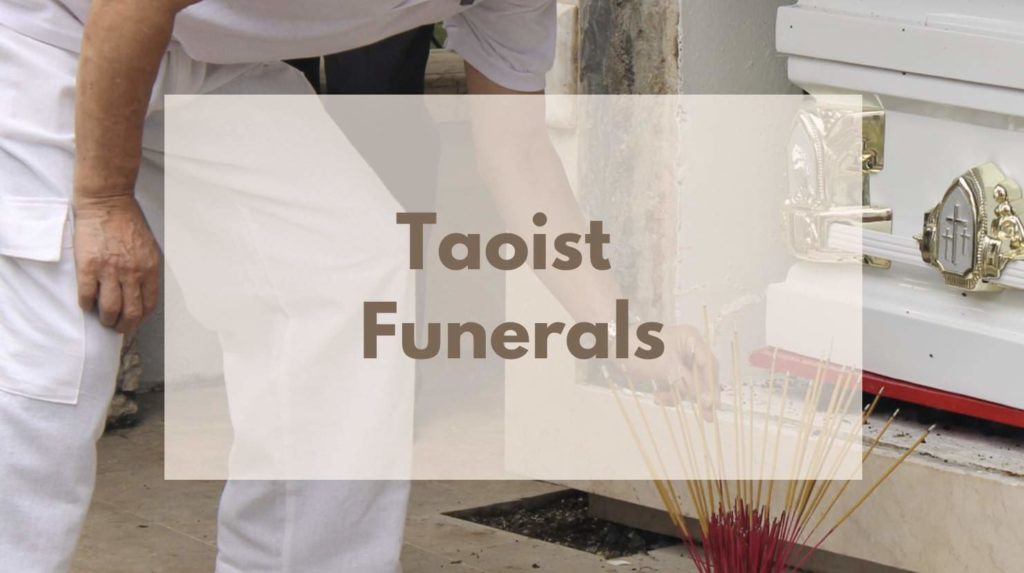
Taoist funeral rites and traditions are generally practised by Chinese families. Customs vary per denomination and dialect group (like Hokkien, Cantonese, Teochew, and Hakka—the most common Chinese dialects in Singapore).
Regardless of these differences, there are still some rituals that are commonly practised among Taoist funerals. These practices revolve around the belief that the body must be freed from evil spirits and monsters.
In order to do that, the family of the deceased must perform a series of rituals to help the soul of the deceased safely pass to the afterlife. Often, families first contact a funeral parlor well-acquainted with Taoist customs to make the arrangements.
The body is then cleaned with a damp towel dusted with talcum powder. Uncleaned bodies are believed to receive punishment in the afterlife.
From there, the body will be dressed in their finest clothes, normally in white, black, brown, or blue. It’s important that the deceased individual doesn’t wear a hint of red as it’s believed that their spirit will turn into a ghost.
Taoist funerals are held an odd number of days, usually lasting for 3, 5, or 7 days. Throughout the wake, a Taoist priest will chant scriptures to ask for repentance of the deceased’s sins.
An altar will also be set up featuring the deceased’s photo, fruit and food offerings, joss sticks, candles, and flowers, among other things.
Before offering a silent prayer, family members and funeral guests also burn joss paper, which come in the form of a house, money, cars, and other papercrafts. This is practised so that the deceased will have enough necessities in the afterlife.
After the wake, a short procession will take place en route to the burial or cremation site. Behind the hearse, the procession is arranged from the eldest male son to the youngest female offspring, followed by other relatives and mourners.
Once the funeral has concluded, there’s a 49-day mourning period with prayers conducted every 7 days. Throughout the period, family members typically wear a mourning pin.
Religious Significance
Taoist funeral customs like those on attire largely revolve around “filial piety”—a Confucian virtue that honors one’s parents, elders, and ancestors.
For instance, wearing bright colours such as red during the mourning period is considered taboo for family members. Mourning pins are also worn throughout the 49-day mourning period.
This practice sets appearance and personal comfort aside to grieve for the deceased.
For Taoists, the deceased may become either of these two entities following death: becoming an ancestor who maintains contact with their family or a ghost that may harm society.
In the case of the former, the deceased has the potential to become a beneficial ancestor who will provide the family with good fortune for many years to come. This is why families try to arrange a good and sometimes elaborate funeral as it’s believed to bring good luck.
It’s also why the living tries to maintain contact with the deceased even after death. This type of contact normally comes in the form of food offerings and lighting joss sticks during death anniversaries or birthdays.
Do’s and Don’ts
Taoist funeral customs can be more elaborate than others, filled with very specific practices that family members and guests should follow. These are some of the do’s and don’ts when attending a Taoist funeral:
Do’s
- Wear appropriate clothing in white, blue, or black.
- Upon arrival, pay your respects to the deceased by lighting a joss stick and offering a silent prayer.
- If lighting joss sticks goes against your beliefs, simply bow, offer a silent prayer, and give your condolences to family members.
- If there are red threads available, tie it loosely to your finger and discard it before going home. This practice is believed to drive back bad luck and evil spirits.
- Although not required, you can also offer “pek kim” to help the family cover some funeral costs. Standard practice is offering at least $30.
- Family members should make weekly offerings to the deceased’s altar throughout the mourning period.
Don’ts
- Avoid wearing revealing clothes and bright coloured clothing, especially red. This is considered highly inappropriate to Chinese families during the occasion.
- Avoid leaving in the middle of chants, prayers, and other rites.
- For family members of the deceased, avoid cutting your hair or nails after the deceased has passed away.
- Family members should also refrain from visiting friends and taking part in “happy” occasions like birthdays, weddings, and outings. Should there be an upcoming wedding, it’s best to postpone it for a year.
Christian Funeral Rites
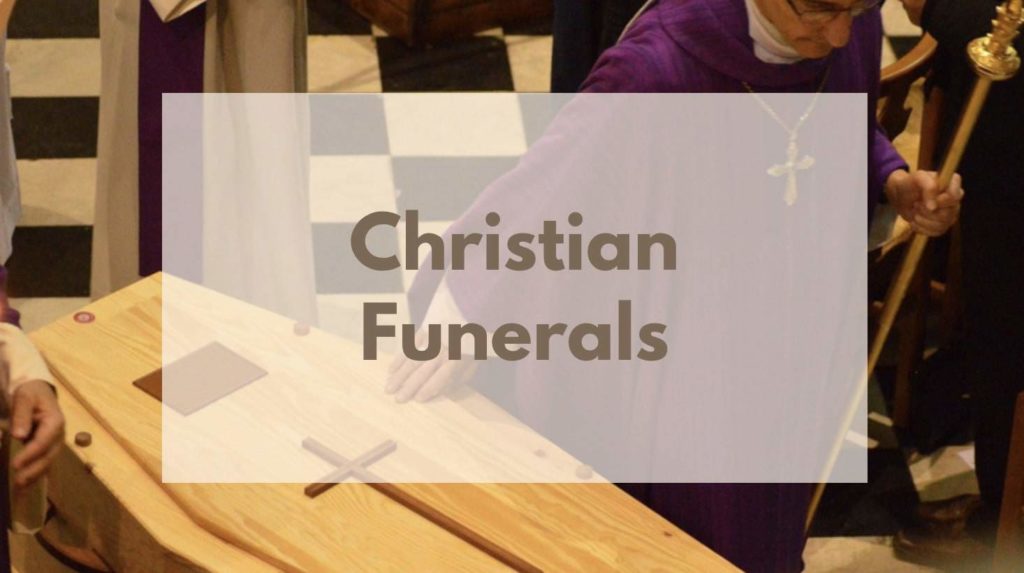
Just like other religions, Christian funeral rites vary per denomination. However, there are several common elements present in Christian funerals.
After a person has passed away, the family contacts a funeral parlor well-versed in Christian funerals or Catholic funerals. There aren’t really strict customs that family members have to do during the time of death apart from offering a silent prayer for the deceased.
Once arrangements have been made, the funeral parlor transports the body to the mortuary to prepare for embalming and viewing. The family then holds a wake usually lasting 3 to 7 days before the burial or cremation, both of which are allowed under Christian beliefs.
In the same way, sea burials for cremated bodies aren’t prohibited either. It’s not always preferred but the practice is generally accepted in many Christian denominations.
During the wake, prayers, tributes, singing hymns, and memorial services are common practices. Memorial services are conducted by a priest or pastor.
Wakes are normally decorated with white drapes, flowers, and a crucifix to symbolise peace and purity. The deceased is dressed in simple clothing, which is also coloured white.
While there are no strict requirements when it comes to attire, family members often wear white as well.
On the day of the burial or cremation, one final service is held by a priest or pastor to bless the departed soul. For burials, family members and other mourners then offer flowers to the deceased, which are also buried alongside the casket.
Religious Significance
For Christians, death is seen as the beginning of eternal life. Christians who have passed away will be judged by God, and will either be sent to heaven or hell depending on how one has lived their life.
Heaven is the ultimate goal for Christians. It’s believed that people who lived righteous and faithful lives will go to heaven to be reunited with God and Christ.
Meanwhile, hell is often depicted as a place filled with eternal fire for souls who haven’t repented. It’s considered as the ultimate punishment for sinful souls.
Some Christian denominations like Catholics also believe in the concept of purgatory, which is a state that souls undergo to be ready for heaven. To get out of purgatory, it’s believed that the living should continuously offer prayers for the departed soul.
Do’s and Don’ts
Unlike other religions, Christians don’t really have strict requirements when it comes to funerals or wakes. Still, it pays to be respectful if you’re planning on attending one soon.
Here’s a reminder of do’s and don’ts to follow:
Do’s
- Dress appropriately, ideally in black, white, gray, and other muted colours.
- Upon arrival, greet the host family and approach the casket to offer a silent prayer.
- If you’re attending a Chinese Christian wake, it’s also common practice to give bereavement money or “pek kim.”
Don’ts
- Avoid leaving in the middle of a service or prayer. You can ask a family member of the schedule beforehand in case you need to leave soon.
- Put your phone on silent mode.
- Don’t touch the bible at the altar.
Muslim Funeral Rites
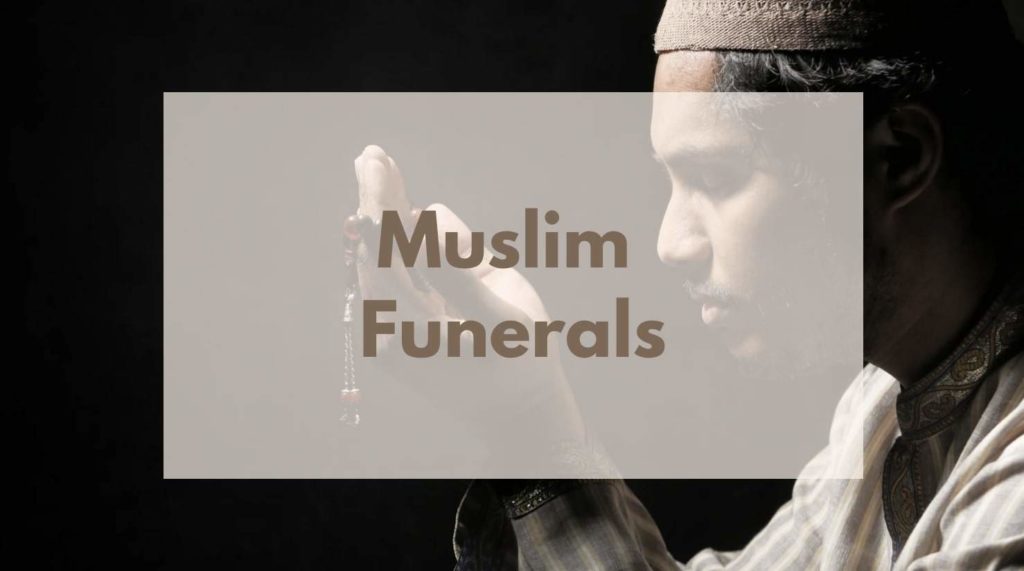
In Singapore, Muslim funerals are normally practised by Malays and sometimes Indians. Under Islamic law, a burial has to be arranged immediately following the passing of a person.
Family members wash the body before covering it with a sheet. After offering a prayer, the body is brought to a mosque where the funeral will take place, usually within 24 hours from the time of death.
Because of this fast pace, there aren’t really any wakes, visitations, or open caskets. Embalming and cremation is also prohibited under Islamic law.
Traditionally, only Muslim men can attend funerals. However, this isn’t always the case, and it’s best to check with the host or Muslim community first.
Once the body reaches the mosque, a funeral prayer must be performed by all members of the mosque. Otherwise, it’s believed that the entire Muslim community will incur a sin if this isn’t practiced.
This sacred prayer is recited outside the mosque, often in the prayer room, community square, or courtyard.
The whole congregation, including the body, then faces Mecca, Islam’s holiest site. From there, the Imam or religious leader will lead funeral prayers and other rituals, which are also conducted outside of the mosque.
Once the rituals are finished, the body is then taken to the burial site, where it will be covered by a layer of wood or stones to avoid direct contact with the soil. Traditionally, mourners present also throw 3 handfuls of soil into the grave.
Due to the scarcity of land in Singapore, the National Environment Agency has implemented a policy to limit the burial period for all graves to 15 years. After that, the grave will be exhumed to transfer the remains to smaller plots.
The mourning period typically lasts for 40 days, but this can vary depending on the family.
Religious Significance
Just like most religions, Muslims also believe that death marks the beginning of the afterlife. According to Islamic belief, one’s time of death is predetermined by Allah or God.
When death comes, Muslims are encouraged to proclaim their faith to Allah called the “tahlil” as their last words. If the person is unable to do so, family members are expected to whisper the proclamation to the dying person’s ear.
It’s also widely believed that a deceased person will stay in their graves until the Day of Judgment, where the righteous will be sent to paradise or “Jannah” while the wicked will be sent to hell or “Jahannam.”
On that note, Muslims believe in physical resurrection on the Day of Judgment, which is why cremation isn’t allowed under any circumstances.
Do’s and Don’ts
Muslim funerals are a community affair. It’s normal to see strangers attend a Muslim funeral since it’s held in a mosque.
Non-Muslims can also attend Muslim funerals, but they have to adhere to specific rules during the proceedings. If you’re not sure what they are, here are the do’s and don’ts in a Muslim funeral:
Do’s
- Wear modest clothes and closed shoes, ideally in white or black. It’s advisable to wear a shirt/dress shirt and trousers for men, and a long-sleeved, loosely-fitted, high-necked top paired with a head scarf for women.
- Be sure to check with the host family first if a woman can attend the funeral as it’s not normally practised. If women are allowed, it’s advised to stay at the back of the group.
- If you wish to bring a gift, you may bring food to the family within 3 days after the funeral. Observe Muslim dietary restrictions if you plan on bringing food.
- During hymns or prayers, you may simply stand or offer a silent prayer.
Don’ts
- Avoid speaking with other attendees, especially if rituals and prayers are taking place. If you wish to share your sympathies with the family, it’s best to do it after the burial.
- Avoid wearing jewelry, bright clothing, makeup, or anything that may draw attention.
- It’s not customary to bring flowers, gifts, and money during the funeral.
Hindu Funeral Rites
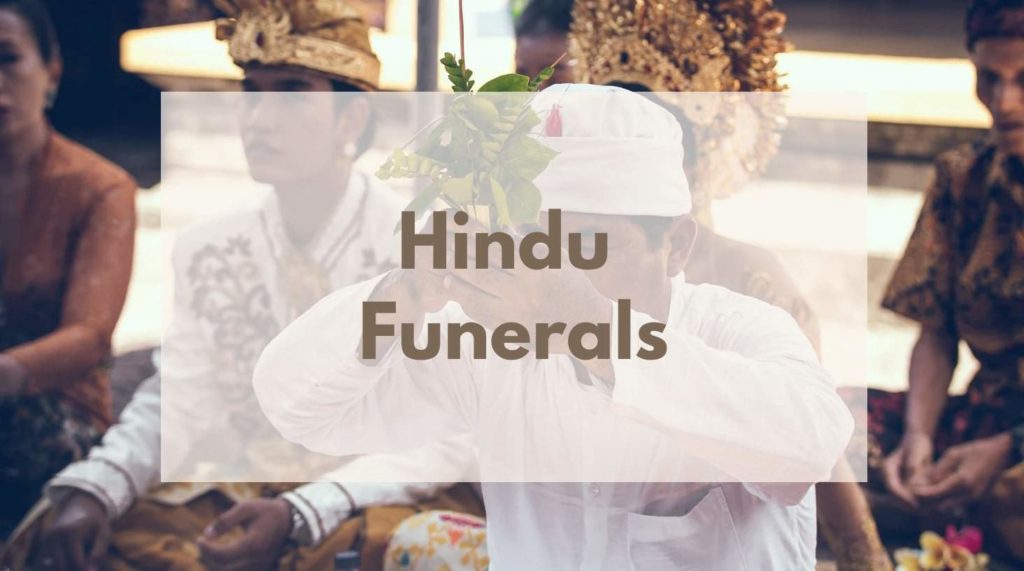
Like most religions, Hinduism also has different sects and subsects, which also means that funeral rites may vary.
According to Hindu funeral customs, the body is kept at home until it’s cremated, which normally happens within 24 hours after death. After the body is washed, the body is displayed in an inexpensive casket with a garland of flowers around the neck.
While embalming isn’t really prohibited, it’s often considered unnecessary due to the fast pace of funeral rites.
Families often call a funeral parlor specialising in Hindu funerals to arrange everything from transportation to the actual cremation.
Before cremation, a funeral service takes place as soon as possible. In Singapore, the wake is normally conducted at the void decks of HDB flats. A priest or “karta” will lead the service, chanting hymns and mantras.
From there, the body will be transported to the crematorium. The ashes of the deceased should then be scattered over a sacred body of water or a place of importance to the deceased.
Some parlors do offer repatriation services for Indian families who wish to scatter their departed’s ashes along the banks of Ganges River in India, for instance.
Ten days after the cremation, a brief ceremony is typically held at home to help the soul reach heaven.
Religious Significance
Hindu funeral rites revolve around the concept of reincarnation. The purpose of funerals and rituals is to help the soul transition to the next life.
Unlike other religions, Hindus believe that the soul has no beginning or end, as it can only transfer from one form to another depending on its karma from the previous life.
Hindus also believe that the body no longer has a purpose once a person has passed away. This is why they practise cremation instead of burials.
It’s believed that the body can hinder the transition of the deceased’s soul to the next form. For this reason, cremation takes place immediately after death.
Do’s and Don’ts
Hindu funerals are pretty straightforward and fast paced, so you might find yourself attending one on short notice. Before that happens, be sure to take note of these do’s and don’ts:
Do’s
- Wear appropriate clothing in white. Some funerals require attendees to wear conservative clothing that covers the knees and arms, so make sure to double check with the host first.
- After greeting the host upon arrival, it’s expected that guests will approach the casket to view the body. Offer a silent prayer from there.
- If there are ongoing chants or hymns during your arrival, simply stand silently in the corner and wait for the ritual to finish before approaching the host.
Don’ts
- Wearing black is considered offensive in Hindu funerals. Be sure to avoid wearing black or dark coloured clothing.
- Don’t bring gifts like food or flowers to Hindu funerals. In some instances, it may even be considered offensive to do so.
- Like other religions, refrain from using your phone or leaving during rituals.
On the other hand, there are also free thinker funerals for non-religious people, which means they don’t follow any kind of custom or tradition. Anything goes in this type of funeral, so our best advice is to just be respectful and honour the departed’s wishes.
In any case, that concludes our guide to funeral rituals in Singapore. We sincerely hope this guide has helped you understand the intricacies of each major religion’s funeral customs.
If you think we missed something, don’t hesitate to let us know!

